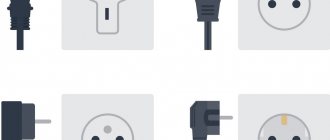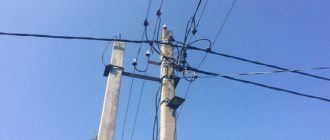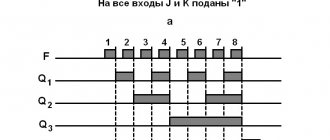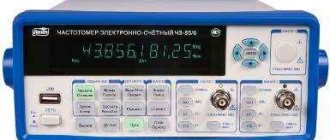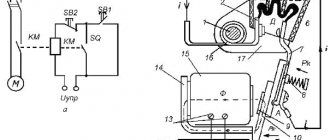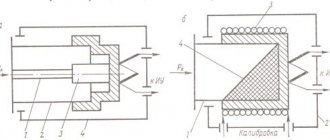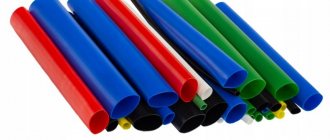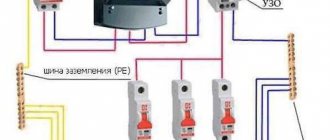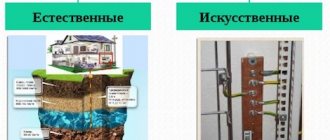Types of terminals
To connect grounding conductors, the following types of terminals are used:
- clamping;
- threaded;
- magnetic;
- disposable;
- special;
- instrumentation
Clamping
Clamp terminals are also called fang terminals. There are also common names - “dog” or “crocodile”. The device includes two components similar to jaws. The moving parts of the product are compressed by a spring, as in a simple clothespin.
Clamping devices include the entire KZ line, including KZ-20. The KS-124 model, popular among electricians, is also clamping. There are also more advanced samples on the market, for example, TWT-LSA-CRML. The peculiarity of this terminal is its ease of installation: it can be mounted and removed with one click.
Due to ease of use and low cost, clamp terminals are the most common on the market.
Threaded
In essence they resemble a clamp. Operating principle: the terminal is securely attached to the part by tightening the thread. A wing nut is used for tightening. As an example of threaded models, we give the Russian UN 42-171 and the American 300A.
Threaded models are not as quick to remove and install as clamp models. However, such terminals are fixed more reliably, thereby creating better surface contact.
Magnetic
Used in places with difficult accessibility or with significant dimensions of the structure. Magnetic products are chosen when it is impossible to use clamping or threaded terminals. Magnetic terminals allow connection to thick metal pipe or DIN rail, as well as to wire mesh.
Note! It is easy to recognize Russian-made products by the abbreviation MKZ.
Disposable
Disposable terminals are used in low-current and signal circuits. Such products are common on personal computers, network cables, and acoustic equipment. Disposable terminals are called disposable because they are removed along with a fragment of the wire, and their further use is impossible.
An example of this group of terminals is the product of the German company ADC Krone.
Special terminals
Used to connect certain parts to the grounding conductor. For example, specialized terminals include those used for grounding wire trays for laying electrical cables. Such trays are made not from metal sheets, but from mesh, due to which the removal of thermal energy from cable lines is more intense.
Trays are grounded not only to overcome the consequences of destruction of the insulating layer. Grounding also ensures the process of equalizing and relieving the potential induced by a current passing nearby. For this purpose, special terminals with conductors fixed in them are installed on the walls of the trays.
Instrumentation
Products of this type are marked with the letter “C”. In foreign practice, such terminals are called “banana”. The device is manufactured as a connecting bus and is used to protect electrical panels, metal racks and electrical cabinets.
Technical specifications
Grounding terminals have the following properties that characterize them:
- the greatest current that the device can pass through itself without being damaged;
- opening index (for canine and threaded models);
- dimensions;
- weight.
The most important quality is the maximum current flow. This indicator is indicated in the labeling in numerical terms. This number must be multiplied by 10 to obtain the permissible current.
Examples of technical data:
- Brand - KZ-20 SK. Designed for 200 ampere current. Dimensions: 140×75×20 millimeters. Weight is 190 grams. The opening index is 50 millimeters.
- Brand - KZ-300 "Krass". It is characterized by increased resistance to high-power discharges.
- Brand - KZ-50. Withstands currents up to 500 amperes.
Where are ground terminals used?
All connecting devices have their own technical characteristics and can be used in almost any area where they are needed. For example, "crocodiles" or "dogs" are used in welding equipment and can withstand voltages from 220 to 380 volts. Higher voltage causes the parts to become very hot, which can cause the wire insulation to melt.
Under the influence of high temperatures, the conductivity of the grounding conductor increases. In combination with damaged insulation, there is a real danger of electric shock to working people.
In this regard, production processes that use powerful equipment require more reliable connections. For such cases, screw terminals are provided to ensure a strong connection and good contact. The only problem with such connections is some difficulty in installing them in place. This requires special tools to tighten the bolts at the contact point. However, no one pays serious attention to this disadvantage, and screw terminals are widely used not only by professional specialists, but also by many home craftsmen.
The most popular connecting devices include the following:
- Clamping ground terminal KZ 20 SK, with which the welding cable is connected to ground. The number present in the marking corresponds to the maximum number of amperes that this mount can withstand. It must be multiplied by 10 to get the final result, that is, 200A.
- Terminal KZ 31 KORD performs the same functions as the previous one. This model has higher power characteristics and can withstand up to 310 amps.
- Another clamp-type terminal, KZ 50, can operate at a current of 500A.
Terminal selection
As an example, here are the factors to consider when choosing a clamp terminal:
- The spring must be elastic enough to hold the part. In addition, a weak clamp will not support the weight of the cable attached to it.
- The clamping device must have a good degree of opening so that it can be installed on large structures.
- The preferred material for sponges is copper.
There are economy class terminals on sale, in which the jaws are made of steel and coated with a thin layer of copper. The problem with steel products is that they become overheated when current passes through them. Externally, it is not possible to distinguish such products from copper ones. To determine the type of product, a magnet will be useful. If the product is made of steel, a magnet will be attracted to it (unlike copper).
If you have already purchased a steel terminal, you do not have to give it up. If you have a piece of copper or brass, the terminals are easy to make yourself. The existing (steel) jaws are used as a template.
When choosing a “dog”, you should pay attention to one more nuance - the location of the copper or copper-plated strip. If there is a risk of the strip coming into contact with a metal structure, it is recommended not to purchase such a model. The presence of direct contact leads to overheating of the terminal spring, which, when the part cools smoothly, ends in its annealing (the steel becomes soft and inelastic). A clamp with changed steel characteristics becomes unusable. To prevent this situation, you will need to either constantly monitor the strip during connection, or select a clamp in which the strip and the contact with the metal do not come into contact.
Quality products are characterized by the following properties:
- high quality materials;
- elastic spring;
- wide terminal opening.
Buying a low-quality product will not only result in its failure and wasted money, but will also lead to downtime of the welding station (due to increased load) or even equipment breakdown. Any product (if it is not a fake) must be supplied with a certificate, which the seller must present upon the buyer’s first request.
Price
The price range for clamps is extremely wide. In addition to Russian-made terminals, the market offers products from foreign companies (Screw, WAGO, WPE, etc.). The cheapest parts cost around 50–60 rubles. Prices for high-quality clamps start from 150 rubles.
The cost of a product is directly affected by its throughput. For example, KZ-20 costs 150 rubles, and a terminal with greater capabilities - KZ-50 - will cost 200 rubles. The most expensive clamps are traditionally magnetic. The MKZ-60 modification is offered in retail establishments for 2,150 rubles.
Types of terminals and area of use
Now in any electrical store you can buy any clamp terminals designed for 124, 300 or more Amps. Moreover, the price of clamps depends on their characteristics and the material from which they are made. Let's look at some types:
- KZ 20 SK is a clamping terminal, an analogue of TWT-LSA-CRML, which is used to connect grounding and welding cables. The number 20 is responsible for the maximum number of Amps that the mount can allow. In this case it is 200;
- KZ 31 KORD – clamping terminal, used to connect the welding machine cable and the ground wire. This clamp has the technical specifications of 310 Amps;
- KZ 50 - accordingly, this is a clamping cable that is used for current up to 500 Amperes;
- The “S” or Banana device terminal is a special connecting bar that is required when installing an instrument cabinet, metal racks or panel. It is mounted on the product body and connected to the ground wire;
Photo - grounding kit for cabinet installation - MKZ-60 is a magnetic terminal with a power of 600A ESAB, which is designed for fastening directly to the workpiece. This could be the surface of pipes, din rails, or wire products.
The magnetic grounding terminal is the most expensive among similar devices. It is suitable for any welding equipment, used for argon welding and other work (for example, at KTP, or KP-03) requiring high current. Equipped with a special non-falling surface, which helps maintain clamping force throughout the entire work process.
There are also terminals of the KZ-300 “Krass” type - powerful clamping devices that allow strong current discharges to pass through.
Nowadays there are various models of devices on the market. There are imported WPE type-2, lever WAGO, Phoenix Contact USLKG 3, Screw feedthroughs. The cost varies between 150–170 rubles per piece, and a special insulated tip is sold with them. Be sure to check the certificate and compliance with the characteristics specified in the price list before purchasing.
Photo - WAGO terminal for five wires
Grounding the Wire Tray
To equalize potentials, a special terminal is used - for a wire tray. Such clamps are widely used to create grounding at production facilities. Special clamping devices are especially popular in fire hazardous areas.
There is nothing difficult about installing the clamp. First, the device is fixed to the tray body, after which a grounding conductor is passed through it.
Note! The insulation must be removed from the area where the green-yellow conductor connects to the clamp. It is most convenient to use a stripper for this purpose.
In large production areas, the terminals are spaced approximately ten meters apart from each other. Trays are grounded in accordance with the standards set out in the Electrical Installation Rules, that is, for each separately. To ensure high safety, it is recommended to use a single-core cable with a cross-section equal to or greater than 2.5 square millimeters. In especially critical cases, it is advisable to use a copper conductor with a cross-section of 4 millimeters.
Please note that each electrified element must be grounded in order to maintain electrical safety in the house.
Grounding terminals for wire trays
Among special grounding terminals, the most typical example is the parts and elements with which wire metal trays intended for laying cable lines are grounded. The material is not ordinary sheet steel, but a wire mesh structure that helps effectively remove excess heat from wires and cables.
Potential equalization is carried out using terminals designed specifically for such designs. They are mainly used in the industrial sector and in facilities with increased fire hazard.
The clamps themselves are very easy to install. First, the grounding terminal for the wire tray is fixed to its mesh body, and then a grounding conductor is passed through it. The docking area must be cleared of insulation. On long trays laid in production, the distance between the fastening points should be approximately 10 meters.
For each structure, a separate grounding is arranged using a single-core cable with a cross-section of at least 2.5 mm2. In order to increase safety at facilities of particular importance, the conductor cross-section is increased to 4 mm2.

